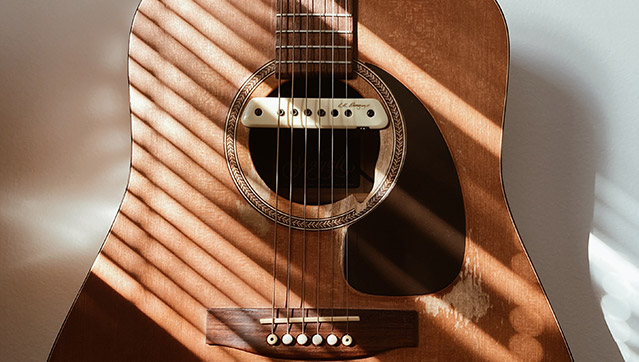There are various types of guitars available in the market. Many of the beginners like to pick the acoustic guitar to start learning. However, even a beginner who has decided on an acoustic is presented with a choice to buy either the acoustic guitar or its close relative – the acoustic-electric guitar.
To add to the confusion we often hear the the term “electro-acoustic” being thrown around. And wonder what exactly are these guitars and how they compare to each other. We’ll find out in this article everything about acoustic-electric guitars and if they would be a better choice for you.
But, first, let me give a short description of all these guitars:
Acoustic-electric guitars which are also called electro-acoustic are a type of acoustic guitar fitted with electronics that enable them to connect to an amp. So, basically, an acoustic guitar that comes fitted with pickups is called acoustic-electric guitars. And electro-acoustic is another name for it.
However, there is much more to all these guitar types than this. Acoustic-electric guitars at first may look like the best of both worlds but some nuances make them not as good as acoustic guitars for some use-cases and situations.
We’ll be taking a close look at everything that would help you make a decision on which type to buy.
What is an Acoustic-Electric Guitar?
Acoustic-electric guitar is an acoustic guitar fitted with a piezoelectric pickup. Some may come fitted with a magnetic pickup or microphone but they are not as common. They are primarily used in live performances as a replacement for acoustic guitars because of their ability to connect to amps and PA systems. Electro-acoustic guitars can provide the same tonal properties as acoustic guitars but at much louder volume.
Piezoelectric pickups which are different from magnetic pickups used in electric and other types of guitars require a preamp to work. A typical acoustic-electric guitar comes also fitted with a preamp that needs a 9V battery. Many of these guitars also have volume, tone, and EQ knobs on the side to control the tone output.
Electro-acoustic guitars use a different type of amp called the acoustic amp. These amps retain most of the original tonal characteristics of the input signal, unlike electric guitar amps. While these guitars can be played through electric guitar amps the sound output wouldn’t be optimal. Acoustic guitar amps also provide controls to add reverb and other effects but they try to keep the original acoustic sound still intact.
The Primary Disadvantage of Acoustic Guitars
Acoustic guitars are great, they are relatively inexpensive, easy to practice with, and all around sound good. However, there is a major disadvantage if you plan to play in gigs – amplifying their sound is not easy and predictable. Let me explain why and how.
The majority of songs that feature an acoustic guitar use a regular acoustic guitar along with a microphone to capture its sound. The reason is because acoustic guitars have a very nuanced sound and people pay a lot of money to buy expensive acoustic guitars that have their unique sound. Acoustic guitars have natural overtones, reverb, and other acoustic characteristics that make them different from electric guitars. To preserve the originality of the tone studio artists use high-end microphones to capture these nuances.
However, in live performance settings, having to sit or stand beside the mic can be an issue. Many guitarists like to move around and it is harder to move along with the mic (although some people fit the guitar with a mic). Another problem is the mic itself, if you play with a band you’d usually be provided a mic for your guitar. This mic can be different on different occasions and may change the tone of your guitar and add unpredictability.
This is the reason why most acoustic guitarists would prefer an acoustic-electric guitar for gigs and live performances. You can be certain of the sound quality and tone. The onboard tuners and EQ also provide a hassle-free way to adjust tone yourself and in between songs, if needed.
Most experienced guitarists would agree that they would use an acoustic-electric for performance and an acoustic with a mic for recording.
Pros & Cons of Acoustic-Electric Guitars
Let’s have a look at all the pros and cons of acoustic-electric guitars in detail.
Pros
- Great sound both unplugged and plugged in
- Good for practicing as well as playing in gigs when an amplified sound is needed
- With the presence of the onboard preamp and tone control, you can adjust the tone to your liking
- Ability for free movement in gigs and performances unlike an acoustic with a microphone
- More predictable and consistent sound reproduction than an acoustic with a microphone
- Ease of switching from acoustic guitars as they are both exactly the same
- Pricing is only slightly more than an acoustic guitar
Cons
- Lack of originality in sound. Studio artists often prefer to use an acoustic guitar with a microphone for this reason. Another option is to use a microphone along with the signal from the pickup, which is what is preferred by many musicians for recording
- It is generally believed that though you can get acoustic-electric guitars in a similar price range as acoustic guitars the sound quality is generally not comparable
- Some electro-acoustic guitars may pose limitations on how low the string action can go due to the pickup placement
Should I Buy an Acoustic or Acoustic Electric Guitar?

Sound Quality
Acoustic-electric guitars offer you the best of both worlds but as with everything in life, there is a catch! Many musicians would agree that while acoustic-electric guitars are great and produce good sound output and tone, they are not on par with acoustic guitars in the same price range. For example, in many cases, a typical $300 acoustic guitar would sound much better than a $400 electro-acoustic guitar, when played unplugged.
So, even if we factor in the price of the electronic components, the acoustic guitar would still come out on top. However, this doesn’t mean electro-acoustic guitars sound bad or anything. For most people and especially beginners, this shouldn’t matter, as they are trying to practice and learn, and not trying to record their next famous song.
Where an electro-acoustic guitar would come short is in the studio setting where a musician is trying to record their music. Not only the pickups alone are insufficient for a great acoustic tone, but the guitar itself, as discussed, doesn’t sound as good as a regular acoustic guitar. Many musicians who own high-quality acoustic-electric guitars may still choose to go with it but along with a microphone to capture the finer nuances of the sound. Ever heard the sound of the string squeaking under the fingers of a professional studio song? That’s what microphones can capture. I love such faithful reproduction of sound, personally. That’s what adds depth to a piece of music rather than a heavily post-processed, clinical sound devoid of any imperfections.
So, if the best possible sound is what you’re after, you’re going to have to go with an acoustic guitar.
For everyone else, an acoustic-electric guitar would be good enough.
Ability to Alter Tone and Add Effects
Both the acoustic guitar (with a microphone) and electric guitars are played through an amp that takes a signal and plays it without too many alterations. The very nature of both these guitars is to preserve the originality of the tone as much as possible.
However, electro-acoustic guitars with their piezoelectric pickups are capable of more tone alterations. You can use the onboard tone controls and EQ to adjust the tone. You can also use the amp settings to add effects that play well with acoustic guitars like reverb. Some people also love the distorted sound of an electric-acoustic guitar, particularly in lo-fi music, where some loss of tone originality is to be expected.
If your music style requires that you have some control over the tone and to be able to add effects, an electric-acoustic guitar would be a better choice for you.
If you wish to play the authentic tone of the acoustic guitar, you can go with an acoustic guitar.
Ease of Playing Through an Amp
Playing through an amp is easy, plug the cable into the guitar on one side and to the amp on the other side. Switch the amp on and you’re good to go.
Not for an acoustic guitar, though. After the lengthy setup of the microphone, you’ll have to make adjustments as to how far or near you want the mic to be from the guitar. Along with your sitting or standing playing position. You’ll also have to be pretty much stationary throughout the performance as any movement may mean the sound going off. Some days you might get a very good sound output, but the issue is the setup can’t always be replicated and is therefore not very predictable.
Even in a home setting when you wish to play plugged with effects, the microphone setup would be a major chore when compared to playing an acoustic-electric.
Therefore, if ease of playing through an amp and a sound output that is consistent across sessions is of the highest priority to you, an acoustic-electric guitar would be a better choice for you.
Price
Typically, the price of an electro-acoustic guitar is only slightly higher than an acoustic guitar in the same range. You can expect to pay around 25-40% extra for an electro-acoustic guitar over a regular acoustic guitar. This can vary depending on the pickups and preamps used on the guitar.
If the sound quality is important to you and you’re on a tight budget and do not want to spend the extra for the guitar itself and then some for the amp, you can go for the acoustic guitar.
Otherwise, if you can shell out the extra dollars for the acoustic-electric you can get away with not buying the amp initially since you can play it unplugged.
Physical Limitations
Some of the acoustic-electric guitars may have a pickup integrated in such a way that it limits how much you can adjust the string action. Some inexpensive acoustic guitars may have somewhat a rigid design and any change in the string action affects how the pickups catch the signal and hence the overall sound output.
In such guitars, you’ll not be able to adjust the string action much without affecting and potentially ruining the sound output.
Why Buy an Acoustic-Electric Guitar – Final Verdict
If you’re a beginner wondering whether you should buy an acoustic or an acoustic-electric guitar, there is little reason not to buy an acoustic-electric. The sound quality is great and comparable to an acoustic guitar assuming you want a sub-$500 guitar. You get a lot more control over the tone and the effects that can potentially be added.
To add to that, you’ll no longer be at the mercy of the band or the technical crew to how you sound for a performance. The sound output from a microphone (used with an acoustic guitar) may not always be as expected and there is more room for inconsistencies. Acoustic-electric guitars, for the most part, solve this issue by giving you a more consistent sound output along with tone controls onboard.
With all these upsides, there is really not much against buying an electro-acoustic, right?
Wrong, acoustic-electric guitars also pose some issues, however, they wouldn’t be of much importance for a beginner.
If you care about the sound quality in the purest sense, then an acoustic-electric guitar just wouldn’t cut it for you. Not only does the sound reproduction from the pickup not sound very authentic in a recording, but the acoustic unplugged sound is affected too. The pickup and the preamp that are integrated inside the sound chamber affect the sound quality.
Also, if you don’t care much about playing through an amp except only on occasions where you can put up with the inconvenience of sitting by the microphone. There is no reason to shell out the extra dollars and get essentially a worse version of an acoustic guitar for the same price. Take it with a grain of salt but the $600-$1000 range for an acoustic guitar is the sweet spot-the best bang for your buck range. If you save a couple of hundred dollars by choosing an acoustic guitar you might get a better sounding acoustic.
Related Questions and Their Answers
Is an Acoustic-Electric Guitar Good for Beginners?
Yes, like the acoustic guitar, an acoustic-electric is a good choice for beginners. The ability to add effects and be able to adjust the tonal output would be preferred by a lot of people.
A good quality acoustic-electric guitar would serve you for years. If you want to join a band later or perform on a bigger level that requires external amplification, you can play the acoustic-electric without having to buy another guitar.
Can You Play an Acoustic-Electric Guitar Without Plugging It In
Yes, you can play the acoustic-electric without an amp because it is basically an acoustic guitar with a pickup and a preamp installed.
What Type of Amps Do Acoustic-Electric Guitars Need?
Acoustic-electric guitars need an acoustic amp which is different from an electric guitar amp. The former tries to reproduce the original tone as much as possible preserving the acoustic sound. While the latter does some tone shaping even without any effects. Electric guitars are seldom played without some kind of tone shaping or effects so amps are designed that way.
You can play the acoustic-electric with an electric guitar amp on the clean channel but the sound quality would not be as good, in most cases.
Can You Amplify a Regular Acoustic Guitar?
Absolutely. The following are some of the options you have:
- Use a microphone to capture the sound – This produces the best quality and the most faithful sound reproduction, particularly in recordings. A high-quality microphone would always produce a more natural and overall better sound than a piezo pickup alone.
- Install an after-market pickup – You can get pretty much the same experience as that of an acoustic-electric guitar by having a pickup installed. One caveat is that you’ll need an external preamp for it to work or an amp that comes with one. Some more expensive pickup kits may come with a preamp but you’ll need professional help to install them. I wouldn’t tinker with my expensive acoustic guitar with these kits though, an after-market clip-on sound-hole pickup would be a better choice in many cases.


